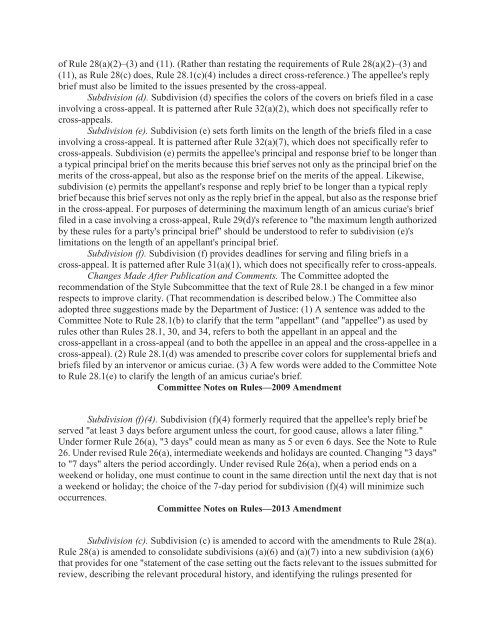Federal Rules of Appellate Procedure 2014-2015, 2014a
Federal Rules of Appellate Procedure 2014-2015, 2014a
Federal Rules of Appellate Procedure 2014-2015, 2014a
Create successful ePaper yourself
Turn your PDF publications into a flip-book with our unique Google optimized e-Paper software.
<strong>of</strong> Rule 28(a)(2)–(3) and (11). (Rather than restating the requirements <strong>of</strong> Rule 28(a)(2)–(3) and<br />
(11), as Rule 28(c) does, Rule 28.1(c)(4) includes a direct cross-reference.) The appellee's reply<br />
brief must also be limited to the issues presented by the cross-appeal.<br />
Subdivision (d). Subdivision (d) specifies the colors <strong>of</strong> the covers on briefs filed in a case<br />
involving a cross-appeal. It is patterned after Rule 32(a)(2), which does not specifically refer to<br />
cross-appeals.<br />
Subdivision (e). Subdivision (e) sets forth limits on the length <strong>of</strong> the briefs filed in a case<br />
involving a cross-appeal. It is patterned after Rule 32(a)(7), which does not specifically refer to<br />
cross-appeals. Subdivision (e) permits the appellee's principal and response brief to be longer than<br />
a typical principal brief on the merits because this brief serves not only as the principal brief on the<br />
merits <strong>of</strong> the cross-appeal, but also as the response brief on the merits <strong>of</strong> the appeal. Likewise,<br />
subdivision (e) permits the appellant's response and reply brief to be longer than a typical reply<br />
brief because this brief serves not only as the reply brief in the appeal, but also as the response brief<br />
in the cross-appeal. For purposes <strong>of</strong> determining the maximum length <strong>of</strong> an amicus curiae's brief<br />
filed in a case involving a cross-appeal, Rule 29(d)'s reference to "the maximum length authorized<br />
by these rules for a party's principal brief" should be understood to refer to subdivision (e)'s<br />
limitations on the length <strong>of</strong> an appellant's principal brief.<br />
Subdivision (f). Subdivision (f) provides deadlines for serving and filing briefs in a<br />
cross-appeal. It is patterned after Rule 31(a)(1), which does not specifically refer to cross-appeals.<br />
Changes Made After Publication and Comments. The Committee adopted the<br />
recommendation <strong>of</strong> the Style Subcommittee that the text <strong>of</strong> Rule 28.1 be changed in a few minor<br />
respects to improve clarity. (That recommendation is described below.) The Committee also<br />
adopted three suggestions made by the Department <strong>of</strong> Justice: (1) A sentence was added to the<br />
Committee Note to Rule 28.1(b) to clarify that the term "appellant" (and "appellee") as used by<br />
rules other than <strong>Rules</strong> 28.1, 30, and 34, refers to both the appellant in an appeal and the<br />
cross-appellant in a cross-appeal (and to both the appellee in an appeal and the cross-appellee in a<br />
cross-appeal). (2) Rule 28.1(d) was amended to prescribe cover colors for supplemental briefs and<br />
briefs filed by an intervenor or amicus curiae. (3) A few words were added to the Committee Note<br />
to Rule 28.1(e) to clarify the length <strong>of</strong> an amicus curiae's brief.<br />
Committee Notes on <strong>Rules</strong>—2009 Amendment<br />
Subdivision (f)(4). Subdivision (f)(4) formerly required that the appellee's reply brief be<br />
served "at least 3 days before argument unless the court, for good cause, allows a later filing."<br />
Under former Rule 26(a), "3 days" could mean as many as 5 or even 6 days. See the Note to Rule<br />
26. Under revised Rule 26(a), intermediate weekends and holidays are counted. Changing "3 days"<br />
to "7 days" alters the period accordingly. Under revised Rule 26(a), when a period ends on a<br />
weekend or holiday, one must continue to count in the same direction until the next day that is not<br />
a weekend or holiday; the choice <strong>of</strong> the 7-day period for subdivision (f)(4) will minimize such<br />
occurrences.<br />
Committee Notes on <strong>Rules</strong>—2013 Amendment<br />
Subdivision (c). Subdivision (c) is amended to accord with the amendments to Rule 28(a).<br />
Rule 28(a) is amended to consolidate subdivisions (a)(6) and (a)(7) into a new subdivision (a)(6)<br />
that provides for one "statement <strong>of</strong> the case setting out the facts relevant to the issues submitted for<br />
review, describing the relevant procedural history, and identifying the rulings presented for


















